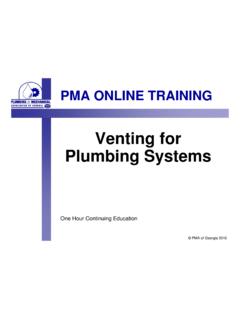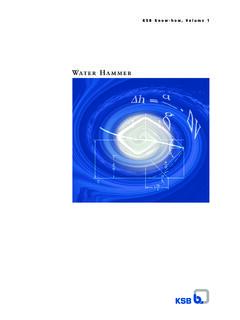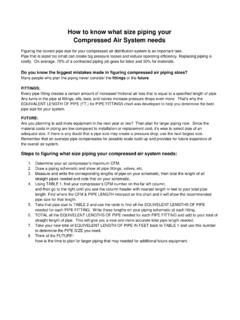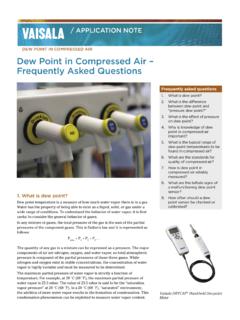Transcription of Air in Water Pipes - CEE Cornell
1 A Publication of AGUA PARA LA VIDA. Air in Water Pipes Second Edition July, 2004. A Manual for Designers of Spring-Supplied Gravity-Driven Drinking Water Rural Delivery Systems by GILLES CORCOS. AGUA PARA LA VIDA is a non-profit organization with branches in the USA and in France and whose purpose is to help remote rural communities acquire enough safe drinking Water . Our members are active in Nicaragua where we have designed and helped build drinking Water supply systems since 1987. We expect to participate in answering this primary need in other countries as well. If you wish to help or to find out more information, you can reach us at: E-mail: Web Site: Agua Para La Vida 2311 Webster Avenue, Berkeley, CA 94705, USA. G ILLES C ORCOS is one of the founders of Agua Para La Vida. He has been a Professor of Engineering at the University of California, Berkeley, specializing in the mechanics of liquids and gases for thirty two years. His first drinking Water project dates back to 1962. The material for this manual was gathered in the field in Nicaragua and in the Laboratory in Berkeley.
2 Dan Mote, then Chairman of the Mechanical Engineering Department supported the work. Several classes of Engineering Seniors chose this very topic for their senior laboratory class and contributed useful data. The author is grateful to them all. **. Please feel free to send your suggestions and comments to 2. INTRODUCTION. W hen you design a pipeline for a gravity flow Water system you usually assume that the Water flow will fill the pipe . In this case the flow rate out of the pipe is controlled by the available head, the length, diameter and roughness of the pipe and the so-called minor losses due to various obstructions (contractions, elbows, expansions, tees and especially valves). We will call this the full- pipe or friction controlled case. It is adequately explained in many textbooks and manuals 1 . But if for some reason the pipe is not completely full of Water , the relation between head available and flow rate is very different. This will happen in several cases. For instance: When you first turn on the Water in a new installation with dry or partially filled Pipes .
3 If you have cavitation somewhere in your circuits (too much suction). If the pipe is fed by a spring through a small spring box and the output of the spring is smaller than the one for which you designed the pipe system. Now, the general belief is that if you have air in the Pipes you need to get rid of it so that the Pipes will run full. This is because the presence of air often increases the head required for a given flow. In fact it is not at all rare that this air acts as a block so that no Water at all comes out at the end of the pipe . On the other hand it turns out that very frequently, in systems with springs of small, uncertain or variable output, there is a big advantage in operating with air in the Pipes . The advantage is that you can design such a system so that it will operate like a canal instead of a pipeline: within limits which you can easily calculate it will deliver to the end of the line whatever flow rate is provided by the spring and this without having to adjust a valve- without controls.
4 This manual is written to help you deal with air in Water Pipes . In particular it will make it possible for you to: Understand the problem of starting with dry Pipes . Predict what will happen if your Water supply is or becomes smaller than you assumed in your calculations (for a friction-controlled system). Design deliberately smoothly operating systems in which air is almost always present in the Pipes . 1 See for instance: A Handbook of Gravity-Flow Water Systems by Thomas , Intermediate Technology Publications ,1984. This handbook covers a comprehensive list of topics including air blocks . While incomplete for our purposes, Jordan's discussion of air in Pipes is nevertheless a valuable start. 3. Throughout this manual we assume that, even though the spring output will vary in time, one of your primary objectives is to convey to the distribution tank through the conduction line a flow rate that is always the full spring output, up to a maximum of your choice. The manual addresses itself in the same time to two kinds of designers: Those who have not had the unpleasant experience of problems with air making their conduits misbehave.
5 Those who, leery of air problems dutifully place an automatic air valve at every intermediate high point of their conduits. First, the hydraulic background necessary to understand this subject is presented. Then the method for predicting and designing with air in the Pipes is given. Finally the manual presents a number of examples that will help you use this material and get on top of the subject. You will find among these examples some friction-controlled designs which get in trouble when the flow rate of the spring is only a little bit less than the design value, as well as cases in which there is no air trouble no matter how much the flow supplied to the pipe by the spring is reduced. After you have followed these examples you will be able to predict whether your friction-controlled design will give you trouble in a specific case. You will also be able to modify your designs so as to eliminate problems with air in the Pipes . The examples make it clear that the problem is not to choose between a friction-controlled full pipe design and a mixed air- Water design but rather to adapt the design to the probability that air will be present in the Pipes some of the time.
6 The standard way to deal with the possibility of blockage with air pockets is to systematically place an automatic valve at every high point of the conduction line. We don't favor this solution for the following reasons: 1) As will be explained in the text when such a valve operates in a supercritical . part of the circuit with transient Water mixed with air it constantly and abruptly opens and closes and that limits its life. 2) Some circuits require no valves at all and no special provisions to deal with ingested air. So for these cases why increase complexity and costs? 3) The placement of air valves near high points is a matter of some delicacy: they have to be placed near the start but within the air pockets which develop (if there is any flow) only downstream of the high points and the location of the high point is rarely obvious. This is an additional argument to avoid placing blindly unnecessary valves. The material which follows is arranged so that the general foundations are given in Chapter I.
7 The way to proceed in a design is given in Chapter II. This chapter is the one that tells you 4. how to deal with air. In other words Chapter II is the "how to" part of the manual, while Chapter I is a reference "why" chapter. Chapter III presents the examples that illustrate the material. Any supplementary information required for the design is found in Appendix A, whether it is new information or available in other books or manuals. Appendix B makes a few more specialized points which would perhaps be confusing in the main text. But these can be read later. The solutions suggested in Chapters II & III are, of course, not the only ones, perhaps not even the best ones. After you have examined this materiel, no doubt you will choose your own. The important thing is to have in hand enough elements to make an enlightened choice. Note: It is possible ( though often tedious) for you to carry out a suitable design without using the equations that appear in the text, by only adding, subtracting, multiplying , dividing and using the tables.
8 The only exceptions are the two formulas of Appendix A-IV. This is shown in Chapters II & III. But you can also download from the web an APLV. program called Air in Pipes that will lead you rapidly (and somewhat more accurately). through your conduction pipe design. The friction law used in the Air in Pipes program is very slightly different from that used in this manual. In particular, the former allows for minor losses and is valid for higher values of the Reynolds number. This accounts for slight differences between calculations carried out following this manual and by means of the program. (See our web site, or request the program from This Visual Basic Excel program is due to Charlie Huizenga with suggestions from Katherine Force, Mathieu Le Corre, Jim Stacey and Gilles Corcos.). The second edition of this manual is the outcome of twelve years of continuous use of the first edition. It incorporates some changes in the presentation and added attention to some cases that have occurred in the field more often than previously anticipated.
9 Many thanks to Kay Force for careful editing and useful suggestions for improving the presentation of this edition. 5. SYMBOLS. h = head (meters). H = height (meters); HAB= height difference between points A and B (meaning HA HB); Subscripts 1&2 refer to two points along the pipe with 1 upstream of 2. Letter S refers to the spring or spring tank. Letter T refers to the pipe outlet or distribution tank. Other points along the pipe are indicated in the sketches. ha = head available (HS HT). ht = trickle height, defined in the text. Appendix A shows you how to calculate it. hf = friction head loss. You can use Table A1 or the formulas in Appendix A to calculate it. hf1 = friction head loss for Q = Qc hr = maximum head required. (hr = hf + ht) if Q is smaller than Qc (hr = hf) if Q is greater than Qc Q = flow rate (m3/s). Qc = the lowest critical flow rate: the flow rate at which, in a horizontal part of the pipe , a long bubble is carried 's value depends only on pipe diameter (see Equations 1c and1d, and Table A2).
10 Qs = the highest critical flow rate: the flow rate at which a long bubble will be carried downstream, regardless of the slope of the pipe . Qmax = maximum expected output (flow rate ) of the spring. minimum expected output of the spring. Q* = Q/Q c or Q/QS. If Q< QC the flow is called subcritical. If Q> QS it is called supercritical. When QC < Q< Q S the flow is transitional. L = length of a pipe line. LST = length along the pipeline from the spring to the distribution tank. LAB = length of pipe between points A and B ..etc. V = Water (section-averaged or discharge) velocity; m/s. g = acceleration of gravity ( m/sec 2). A = cross sectional area of the pipe interior 6. CHAPTER I. AIR IN THE PIPELINES. Air may be found in Water pipelines mainly as large, stationary pockets, or as large or small moving bubbles. When air collects in parts of the pipeline, without moving, the Water may be blocked by the air so that no Water flows or it may circulate past the pockets of air by flowing underneath these pockets.






